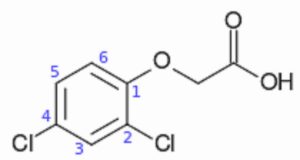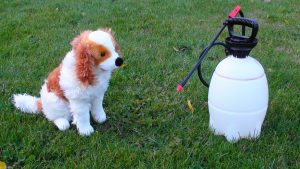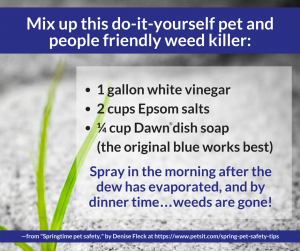Spring is a time when people work and play on their lawns. It is also when many folks apply weed killers. I did so for years and thought nothing of it. Then in 2016 I read an article in a local newspaper and learned that a nearby village was spraying a particular brand of lawn chemical in a dog park, so I did some research.

2,4-D drawing Source: Wikipedia.com
Many weed killers contain 2,4-Dichlorophenoxyacetic acid (2,4-D). I learned there are over 3,000 sources in the scientific literature on this chemical. I did not read them all, nor did a (molecular biology) scientist friend of mine who did his own research on my behalf, but between the two of us we found plenty of disturbing data.
I focused on the product used by the village and read some alarming warnings on the label. These included phrases such as “Danger: Corrosive. Causes irreversible eye damage” and “May be fatal if swallowed.” The warnings also stated the user must wear a face shield or goggles, a long-sleeved shirt, chemical-resistant gloves and eye protection while using the product.
I never took such precautions, and do not see people in the village doing so either. Nor have I seen professionals spraying lawns using such safety measures. As I drove through the village one day I saw a man spraying his lawn without any protection, while his Golden Retriever watched just a few feet away, downwind.

Source: Happy Buddha Dog Training
Lars Neumeister, an independent pesticide expert, wrote “The Risks of the Herbicide 2,4-D” in 2014. He explained Dioxin is a highly toxic byproduct of Agent Orange, and high levels can still be found in some 2,4-D mixtures.2,4-D, when combined with 2,4,5-T produces Agent Orange, the defoliant used during the Viet Nam war. One of my best friends, a U.S. Marine, eventually died from his exposure to it.
The spray is highly volatile and will drift by wind to other locations. This means that even if you do not use lawn chemicals, your neighbors who do are likely contaminating your property.
PetMD posted an article (“The Dangers of Lawn Chemicals: Is Your Perfect Lawn Killing Your Pet?”). It cited a (2013) study which took urine samples from dogs in 25 households to determine whether there was chemical contamination. In 14 of the 25 households, chemicals were detected in the dog’s urine prior to lawn application, and in 19 households afterward. Lawn chemicals may also be tracked by kids and dogs into the home.

Is it worth the risk? Source: Happy Buddha Dog Training
Cogent Medicine published “Indoor risks of pesticide uses are significantly linked to hazards of the family members”, by Muhammad Sarwar, to warn of a range of dangers due to lawn chemical contamination.
In 2015 the International Agency for Research on Cancer declared 2,4-D a possible human carcinogen.
National Resource Defense Council wrote in 2016 declaring 2,4-D “The most dangerous pesticide you’ve never heard of” and described a growing body of scientific evidence linking exposure to 2,4-D and cancers such as non-Hodgkin’s lymphoma and sarcoma.
Several scientific studies link lawn chemicals to cancer in dogs, and in 2017 Tufts University School of Veterinary Medicine published a six-year study that associated the use of lawn pesticides with a greater risk of canine malignant lymphoma, which is a model for non-Hodgkin’s lymphoma in humans, and sarcoma.
In a “Life With Dogs” online article the author wrote about the study and “Specifically, the use of professionally applied pesticides was associated with a significant 70% higher risk of canine malignant lymphoma.”
Considering how less informed and less careful the average homeowner may be than a professional, I wonder how much greater the risk is to pets and children who are exposed to lawn chemicals.
As a homeowner I do not want a yard full of weeds, but I also do not want pets full of cancer. I chose a non-chemical option.

Source: Denise Fleck
One alternative to toxic chemicals is offered by Denise Fleck. She suggests mixing one gallon of white vinegar, two cups Epsom salts, one-quarter cup Dawn (blue) dish soap in a sprayer. “Spray in the morning after the dew has evaporated and by dinner time…weeds are gone.”
I have used this mix to good effect but if you try this I suggest spot testing for results. My lawn is not perfectly beautiful, but it is perfectly safe. My dogs and I can live with that.
Resources:
International Agency for Research on Cancer. Available at: https://www.iarc.fr/
National Pesticide Information Center (Fact Sheet). Available at: https://npic.orst.edu/factsheets/24Dgen.html
National Resource Defense Council. Available at: https://wwwlnrdc.org
Neumeister, Lars. (2014) The Risks of Herbicide 2,4-D. Available at: https://www.testbiotech.org/sites/default/files/Risks%20of%20herbicide%202_4-D_0.pdf
Sarwar, Muhammad. (2016) Indoor risks of pesticide uses are significantly linked to hazards of the family members”. Available at: https://www.cogentoa.com/article/10.1080/2331205X.2016.1155373.pdf
Tufts University School of Veterinary Medicine. Available at: https://www.tufts.edu
Vermes, Krystle. (2014) The Dangers of Lawn Chemicals: Is Your Perfect Lawn Killing Your Pet? Available at: https://www.petmd.com/dog/care/dangers-lawn-chemicals-your-perfect-lawn-killing-your-pet
